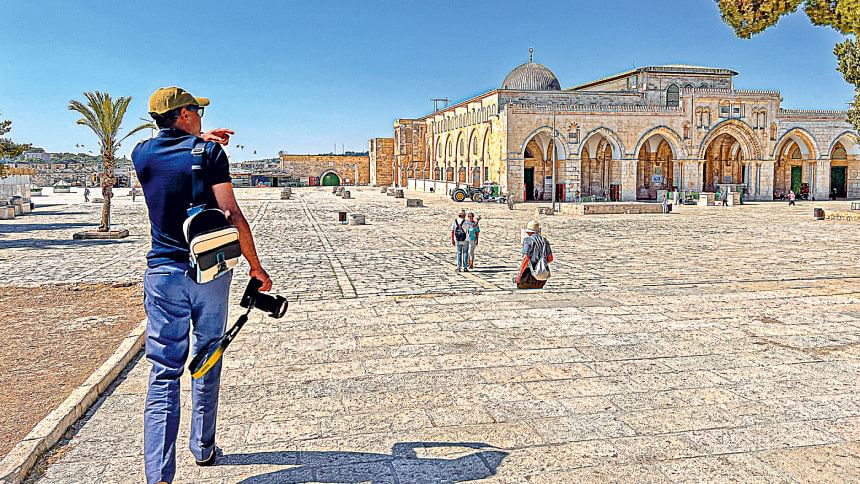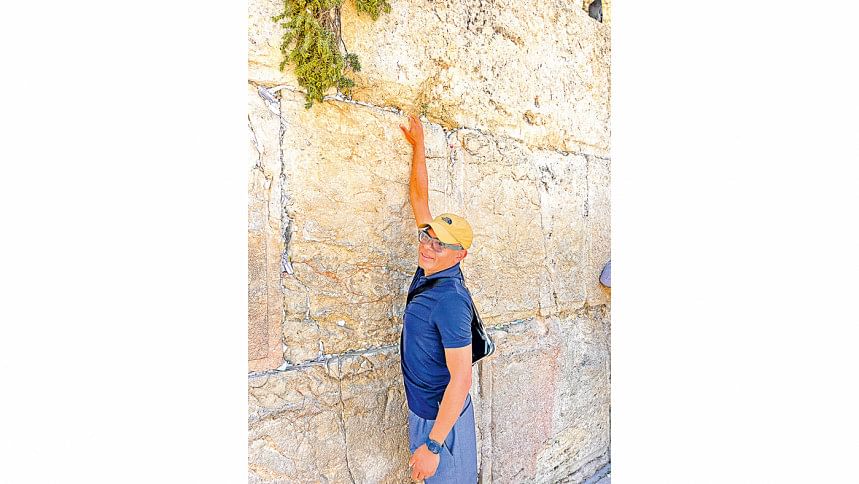Jerusalem the land of Abrahamic religions

Let me be clear; as a Muslim, travelling to Israel is somewhat tricky. Even one of the most powerful passports in the world does not guarantee you an easy entry there.
We had to wait for more than four and a half hours at the Ben Gurion Airport, Tel Aviv, without any particular reason. Nobody misbehaved, but we felt that they wanted us to feel exhausted. After travelling 88 countries, we certainly know when you are welcome to a country or not.
Well, that can't be an excuse to discourage you from travelling to Jerusalem, a city like no other. This ancient city is a prime pilgrimage site for three major religions in the world and a treasure trove for historians.
We planned to visit Jerusalem in 2020 but could not make it due to the Covid-19 pandemic. An opportunity came to us again in July this year. We grabbed it.
On July 02, we flew to Tel-Aviv from our home, Connecticut, USA. We stayed the next six days in Israel -- 4 days in Jerusalem and two days in Tel-Aviv.
From Jerusalem, we visited Bethlehem and East Jerusalem, both parts of the Palestinian Territory.

Sarmin Shahariath and Rejaul Bahar, married since 2005, are avid travellers. Born and raised in Bangladesh, they both are now settled in the United States. So far they have travelled 88 countries across seven continents.
History mingled with myths and faiths has created the legend of Jerusalem. The land of origin of Abrahamic religions is not merely a part of history. It has played a pivotal role in shaping the world as it is.
Since Abraham (Ibrahim), many history-makers walked the alleys of Jerusalem. Jews believe their first and second temples were seated where today's Al-Aqsa mosque is. They call the Al-Aqsa mosque complex Temple Mount. The Western Wall of the Al-Aqsa mosque complex remains their holiest place.

Christians believe Jesus was born in the Palestinian Territories of Bethlehem, only 10 kilometres south of Jerusalem. He was sentenced to death next to the Al-Aqsa mosque and crucified just a few blocks away from it. Muslims believe their Prophet Muhammad (PBUH) ascended to heaven from the Golden Dome in the Al-Aqsa complex.
Conflicts, bloodshed and displacements in Jerusalem go back thousands of years — including biblical times. The city was controlled by Babylonians, Greeks, Persians, Romans, Crusaders, Ottomans and the British for centuries. Sadly, the situation is no different now, and its future remains far from clear.

History mingled with myths and faiths has created the legend of Jerusalem. The land of origin of Abrahamic religions is not merely a part of history. It has played a pivotal role in shaping the world as it is.
While writing this story, a brief escalation between Israel and Palestinian militants killed 31 people, including six children, in the Gaza strip, a Palestinian Territory termed an open-air prison by human rights advocates.
But let's not delve deep into complex political discourse.

From the airport in Tel-Aviv, Jerusalem is only 45 km away. A taxi took us there in less than an hour. On arriving at the Old City of Jerusalem, we checked into an Airbnb in a Jewish Quarter as we wanted to stay inside the old town. Everything was within 10-15 minutes of walking distance.
The Old City is a tiny place (less than a square kilometre) surrounded by ancient walls. The area, excluding the Al-Aqsa complex, is divided into four uneven quarters: the Muslim Quarter, the Christian Quarter, the Armenian Quarter, and the Jewish Quarter. The walls and gates of the city, as it stands today, were built between 1535 to 1542 by the Ottomans.
The next day, we arrived at the Al-Aqsa Mosque complex early in the morning. All the gates of the complex are open to Muslims. Non-Muslims can visit the site but are not allowed to enter any mosques.

The 36-acre complex houses several establishments including the Al-Aqsa Mosque (The Noble Sanctuary) and the Dome of the Rock. Inside the Dome of the Rock, the Golden Dome sits right above the exposed rock from where Muslims believe their last prophet ascended to heaven. Beneath the rock, there is a small cave.
You don't have to be a believer to be humbled by the experiences. We felt lucky to visit the holy sites, off-limit to Bangladeshis.
For the Jewish community, the complex is known as Temple Mount, their holiest place on earth. They believe their two temples once stood here. According to them, King Solomon (Islam's prophet Sulaiman) built the First Temple around 3,000 years ago. The Babylonians destroyed the temple about 2,500 years ago. King Herod the Great built the second temple in the same location only to be destroyed again by the Romans 40 years after Jesus died. The remnant of the Second Temple (Western wall of Al-Aqsa Complex) still stands.

Still today, Jews flock from all over the world to pray here, to mourn the destruction of their temples.
History is written all over the Old City. There are two significant Christian churches, one adjacent to the northern wall of the Al-Aqsa complex and the other one just 600 meters west. It takes less than 10 minutes to walk between these two churches.
The first is the Church of the Condemnation where Jesus was sentenced to death. Second is the Church of the Holy Sepulchre where Jesus was crucified and buried. In between the two churches, Jerusalem's alleys are marked with 14 stations marking the stages of the crucifixion of Jesus.

During our tour, we visited both the churches and walked through all the stations. It was very early in the morning, and only very few people were around. The church was built about 300 years after the crucifixion. The ambience inside the church touched us the most. The air was heavy with history. The silence and emotion of worshippers were overwhelming.
The next day we decided to visit Bethlehem, a Palestinian city where Jesus was born. We visited the Church of the Nativity where a silver star on the floor marks the birthplace .

We stayed in Tel-Aviv for two days to feel the vibe of modern Israel before taking our flight back home to the US. During the whole visit, I couldn't stop myself from asking a question, again and again.
Is this holy Jerusalem --a promised land for the Jews, a place where Jesus lived and died for all the sins of mankind, and from where Prophet Muhammad (PBUH) ascended to heaven -- worth fighting for in the name of God?

We might never know.
We must say that we didn't feel insecure or any tensions or discrimination during the rest of the trip. If the initial discomfort at the airport was the price we had to pay for visiting this unique window into the past, it was worth it.

EXPENDITURES: Staying in Jerusalem and Tel Aviv is as expensive as other large cities across the globe (NYC, London, Hong Kong etc.) The week-long trip for two may cost around 6 thousand USD.


 For all latest news, follow The Daily Star's Google News channel.
For all latest news, follow The Daily Star's Google News channel. 



Comments